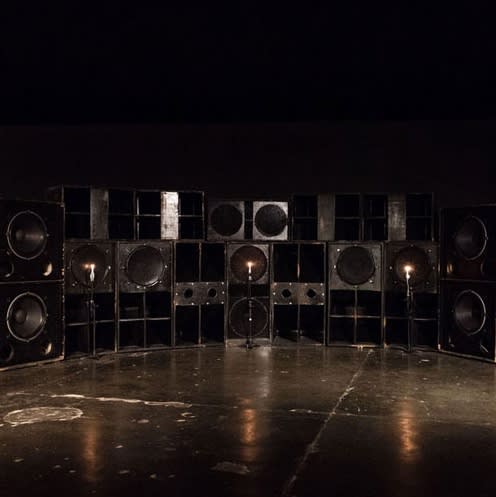The biennial sets forth an environmental agenda of sorts, as though a detachment from the core values of a technology-driven, consumption-crazed society were the antidote to humanity’s excesses, which find a surrogate to Brazil’s political instability in the form of global warming and the havoc it threatens to wreak on the planet. This explains the rather instrumentalized use of footage from indigenous rituals, documented by artist collective Vídeo nas Aldeias. Leon Hirszman’s films featuring songs sung by workers in cocoa and sugarcane plantations add another layer to this romantic vision of indigenous and underprivileged populations as a source of inspiration in the fight against the evils of environmental destruction wrought by corporations.
The contrast that the biennial establishes—between the poetry-laden world of indigenous constructions and the brutality of modernism—sometimes comes across as a rather Manichean vision of the world, weakening the impact of the show. But it manages to rebound forcefully with its selection of artworks that rehash and revamp geometric abstraction, especially Felipe Mujica’s flags with triangular patterns and Ana Mazzei’s forest of delicate sculptures that look like lines materialized on a stage. Their thin wooden and metallic frames echo Michael Linares’s massive collection of wooden instruments, Mariana Castillo Deball’s bamboo carousel from which drawings hang, and the wiry contraptions made by Iza Tarasewicz and Sonia Andrade.
While geometric abstraction has a strong footing in the history of the Brazilian avant-garde, there is an edge to the works shown here, as though they were halfway between industrial austerity and organic unpredictability. Out on a limb, some slick works in the show make up the other end of the spectrum: Francis Alÿs’s mirrored walls displaying schematic paintings that suggest forces of nature at play; Michal Helfman’s film about a would-be humanitarian stream of contraband delivering bare essentials to a war-torn Syria; Hito Steyerl’s sterile installation about the overbearing power of robots coupled with pop music’s obsession with words like “hell,” “yeah,” “we,” “fuck,” and “die”; and the sleekest of them all, Park McArthur’s steel boxes filled with surgical gloves that are scattered around the pavilion near the entrance to every bathroom.
In a way, this dichotomy between humanity’s intimate relationship to the environment and the shimmering bells and whistles of high-end technology subvert the exhibition’s ambivalent position. Addressing a state of uncertainty requires more than a carefree, flowers-in-your-hair, sun-drenched delirium. It’s as dirty an affair as can be, and latex-covered hands delving into wet, spasmodic organs conjure up the B-side, or perhaps the true essence, of what at the surface may read as a hippie dream.
Loud and thunderous, Vivian Caccuri’s wall of speakers lined up in a semicircle around two innocent-looking candles delivers the booming message of these uncertain times. The sound system is designed to play only the lowest frequencies of each composition, constituting what she sees as an altar for bass. Once every hour, her work shakes and rattles the entire pavilion, like a volcano periodically surging to life. It feels deeply rooted in ancestral forces, while at the same time subject to the whims and fancies of ephemeral, manufactured pop anthems, a tension that lies beneath all the most powerful works in the show.

